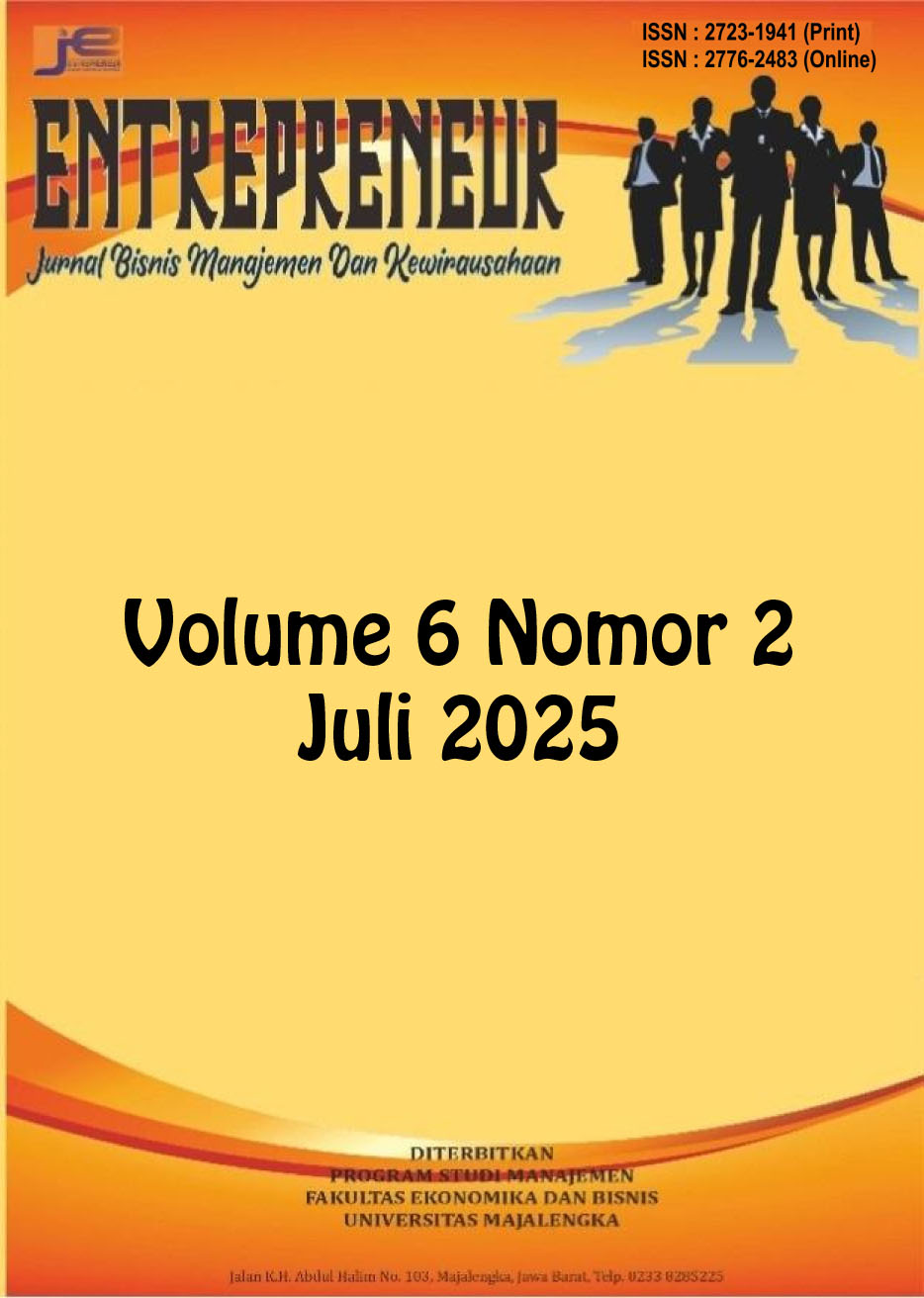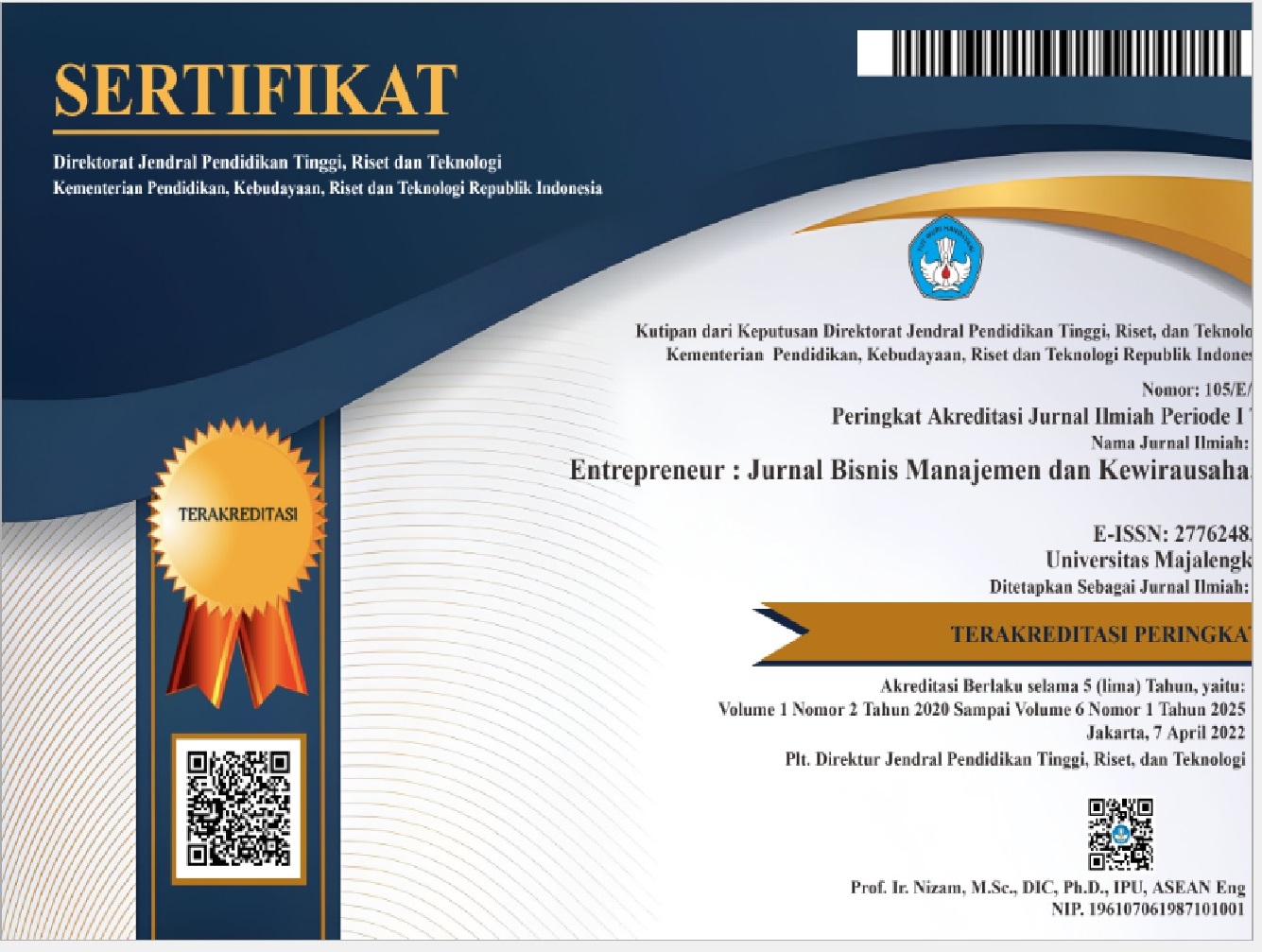Pengaruh Rasio Keungan Terhadap Kinerja Keungan pada PT Bank Syariah Indonesia TBK
DOI:
https://doi.org/10.31949/entrepreneur.v6i2.14898Abstract
This study is intended as an effort to evaluate the extent to which financial ratios affect the performance of PT Bank Syariah Indonesia Tbk (BSI) during the period 2021 to 2024. The focus of the study covers four main ratios, namely Financing to Deposit Ratio (FDR), Non-Performing Financing (NPF), Capital Adequacy Ratio (CAR), and the ratio of Operating Costs to Operating Income (BOPO). Financial performance is measured using two indicators, including Return on Assets (ROA) and Return on Equity (ROE). The approach used is quantitative descriptive by applying multiple linear regression analysis and F-tests and t-tests in order to determine the simultaneous and partial effects. Findings from the analysis results show that the four ratios collectively have a real impact on ROA and ROE. Individually, FDR has a positive and significant impact on ROA, while NPF and BOPO have a negative impact on financial performance. Meanwhile, CAR has a positive impact on ROA, although the level of significance is inconsistent. This finding emphasizes the importance of effective management of financial ratios to improve BSI's profitability and efficiency. This also supports the achievement of the Bank's strategic objectives as a competitive Islamic financial institution at the global level.
Keywords:
CAR, FDR, ROA, ROEDownloads
References
FATIMAH, U. S. (2022). Pengaruh Pembiayaan Mudharabah, Musyarakah dan Murabahah Terhadap Profitabilitas BPRS di Indonesia Periode Sebelum dan Sesudah Covid-19.
Fau, C. P. (2018). Analisis Kinerja Keuangan Pt. Garuda Indonesia Tbk. Tahun 2014-2018. Sumber, 110, 730.
Hery. (2018). Analisis Laporan Keuangan: Pendekatan Rasio Keuangan. Jakarta: Grasindo.
Hery. (2021). Akuntansi Keuangan Menengah. Jakarta: Grasindo.
Ismail, M. (2018). Manajemen Perbankan: Teori dan Praktik. Jakarta: Kencana.
Joel, G. & Shim, J.K. (2016). Accounting Handbook. New York: Barron’s Educational Series.
Kasmir. (2019). Manajemen Perbankan. Jakarta: RajaGrafindo Persada.
Munir, M. (2018). Capital Adequacy Ratio dan Kesehatan Bank. Jurnal Ekonomi dan Bisnis Islam, 5(2), 77–85.
PT Bank Syariah Indonesia Tbk. (2021–2024). Laporan Tahunan. Diakses melalui: https://ir.bankbsi.co.id
Putri, L. & Heryanto, R. (2020). Pengaruh Rasio Keuangan terhadap Kinerja Keuangan pada Bank Umum Syariah di Indonesia. Jurnal Ekonomi dan Bisnis, 7(1), 45–55.
Putri, S., & Dharma, Y. (2016). Pengaruh Likuiditas dan Rentabilitas terhadap Kinerja Keuangan.Jurnal Ilmiah Akuntansi dan Bisnis, 1(2), 89–97.
Ramadhani, F. & Fahmi, I. (2021). Analisis CAMELS dan RGEC terhadap Kinerja Keuangan Bank Syariah.Jurnal Akuntansi dan Keuangan Syariah, 5(2), 112–124.
Rengganis Oktalia, et al. (2020). Pengaruh Kinerja Keuangan terhadap Nilai Perusahaan pada Bank. Jurnal Ekonomi dan Bisnis Syariah, 8(1), 44–53.
Simamora, D. S., Silaban, N., Mendrofa, T. R., Toruan, G. A. O. L., & Sipayung, R. (2023). Analisis Rasio Keuangan Terhadap Kinerja Keuangan Pada Pt Adaro Energy Tbk Periode 2018-2022. Jurnal Maneksi (Management Ekonomi Dan Akuntansi), 12(3), 648-655.
Surya, R. (2018). Kinerja Keuangan dan Faktor-faktor yang Mempengaruhinya. Jurnal Ekonomi dan Akuntansi, 10(1), 66–74.Syariah.
Tamba, A. B. E., Fuadah, L. L., & Aryanto, A. (2018). Analisis Penilaian Tingkat Kesehatan Bank dengan Menggunakan Metode RGEC pada Bank Umum Swasta Nasional Devisa yang Terdaftar di BEI. Akuntabilitas, 12(1), 1-14.
Wibowo, T. & Faturohman, T. (2022). Evaluasi Kinerja Keuangan Pasca Merger pada PT Bank Syariah Indonesia Tbk. Jurnal Keuangan Islam, 4(3), 88–97.
Yuliani, W. (2018). Metode penelitian deskriptif kualitatif dalam perspektif bimbingan dan konseling. QUANTA: Jurnal Kajian Bimbingan Dan Konseling Dalam Pendidikan, 2(2), 83-91.

Published
How to Cite
Issue
Section
License
Copyright (c) 2025 Munti Metralia, Sindi Aprilia, Dira Oktarini, Dola Andini

This work is licensed under a Creative Commons Attribution-ShareAlike 4.0 International License.
COPYRIGHT NOTICE
An author who publishes in the Entrepreneur: Jurnal Bisnis Manajemen dan Kewirausahaan agrees to the following terms:
1. Author retains the copyright and grants the journal the right of first publication of the work simultaneously licensed under the Creative Commons Attribution-ShareAlike 4.0 License that allows others to share the work with an acknowledgment of the work's authorship and initial publication in this journal
2. The author is able to enter into separate, additional contractual arrangements for the non-exclusive distribution of the journal's published version of the work (e.g., post it to an institutional repository or publish it in a book) with the acknowledgment of its initial publication in this journal.
3. The author is permitted and encouraged to post his/her work online (e.g., in institutional repositories or on their website) prior to and during the submission process, as it can lead to productive exchanges, as well as earlier and greater citation of the published work







